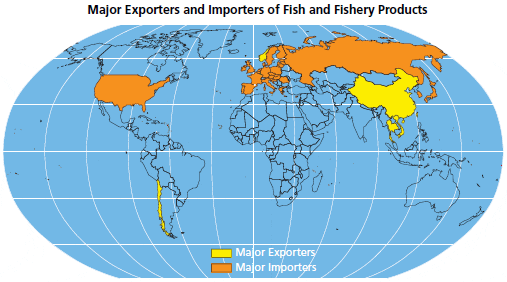
Global Fish Economy
Markets continue to be influenced by uncertain economic sentiments in traditional markets. In Japan, a weaker currency has made imports more expensive. And in the US, imports for the first half of the year were flat in both values and volumes. Developing country demand has been more positive with domestic demand boosting both imports and local production, particularly of farmed products.
Import duties for fish and fishery products for exports to developed country markets are generally low or nonexistent. Thus, market access in the fisheries sector hasbecome more a question of the exporter’s ability to adhere to regulatory requirements in the importing country than an issue of tariffs. However, the proliferation of new voluntary market-based standards linked to sustainable production, traceability and certification are adding cost to the product with little immediate benefit to producers.
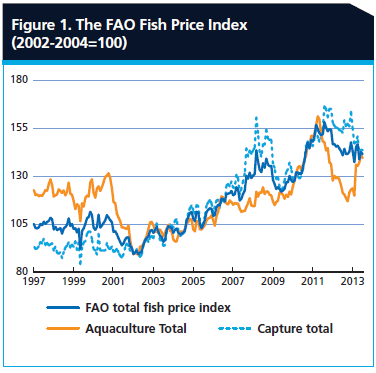
The outlook for the rest of the year is one of firming demand and somewhat higher prices in the run-up to endof- year festivities. A number of species continue to be in short supply and prices will remain at sustained level. Early 2014 is likely to see a somewhat weaker market again.
Whitefish, one of the most important commodities in global production and trade, has received a lot of attention this autumn from industry operators who have seen the whitefish market revitalized. The revitalization is due to the recovery of a number of wild whitefish stocks and continued growth of farmed whitefish species.
| The values of the FAO Fish Price Index for January-May 2013 published in the June 2013 issue of Food Outlook have been revised to reflect official trade statistics made public after the date of publication. The FAO Fish Price Index is based on official import data from the world’s major importing markets for fish and fishery products. The values for January to May 2013, published in the June report, were estimated by FAO. The numbers published in this report (up to July 2013) are all based on official statistics. |
Several conferences have been held globally, with focus on specific species. The INFOPESCA-FAO World Tilapia Conference, held in September in Brazil, presented the latest trends for the species. Its annual production has reached 3.5 million tonnes, expanding in Asia, South America and Africa with new supply targeting domestic and regional consumption rather than international markets. In Europe, demand for the species remains limited, indicating the need for active marketing and promotional activities to raise market awareness.
The CONXEMAR-FAO World Whitefish Congress, held in September in Spain, brought together world experts on major whitefish species. Although some stocks are still under pressure, the recovery of cod in Northern European waters has created a new market for fresh cod in continental Europe.

The Groundfish Forum, held in October in Austria, brought industry leaders together to discuss the supply situation and demand trends. World whitefish markets used to be dominated by traditional groundfish species such as cod, hake, saithe and pollack. Now, with the advent of aquaculture, this has completely changed. Tilapia and catfish have made inroads in traditional groundfish markets which has also permitted the sector to expand substantially and reach new consumer groups.
Review by fish product
Groundfish
In spite of speculation that cod prices would be low, cod actually registered a general price increase during the late spring and summer. However, an almost 1 million tonne 2013–2014 cod quota for the Barents Sea – 25 per cent higher than last year - is expected to push prices down in the near future, at least for the more traditional products. Abundant supply of fresh cod led to dramatic growth in Norwegian exports during the first half of 2013, with the US imports of cod from the world’s major processor and re-exporter, China, also increasing. Haddock is less plentiful, and prices have risen on the European market. Russian catches of pollock increased slightly during the first half of 2013 but US imports of double frozen pollock blocks decreased by as much as 28 per cent, due to China’s supply problems. German imports of Alaska pollock fillets also declined. In New Zealand, the hoki quota is expected to be increased further for the coming season to 150 000 tonnes, up from 130 000 tonnes in 2012 and demand for hoki is good. Surimi exports from the US increased during the first half of the year in volume terms but value was down as prices fell. In Japan, demand for surimi was evidently weak in the first half of 2013, whereas demand in China is currently too strong to be met by domestic production alone and imports of both prepared surimi products and raw material have risen. Overall, it seems that there is a widely diversified market for whitefish products that is behaving quite differently these days from the norms of the past, with cod prices rising even with increased supplies.
Tilapia
Official figures for 2012 tilapia production in China have not been released yet, but total volume has been estimated at 1.5 million tonnes, up from 1.4 million tonnes in 2011, in response to increased domestic and foreign market demand. However, thus far in 2013, industry sources report at least a 30 per cent decline in production in the first half of the year, due to farmers’ financial constraints in restocking of ponds. This decline has pushed prices up amidst renewed interest from buyers in China’s major market, the US. The US is now also increasing imports of fresh fillet from Central America, to an import volume of 14 100 tonnes in the first two quarters, while total imports of tilapia were down 10 per cent to 97 000 tonnes. Meanwhile, EU imports of frozen tilapia fillet are up this year, although volumes are still relatively low. Asian exporters, particularly China, supply 99 per cent of the EU market.
China continues to dominate tilapia supplies for the international market, but production has fallen by 30 per cent in the first half of this year. Demand in consuming countries is increasingly being met by domestic producers, and local production is keeping the market firm as tilapia farming gains more attention worldwide. In addition to Taiwan PC expanding production and increasing market share, African producers are now seeing tilapia’s potential for domestic consumption and for export. Tilapia from Uganda will soon be available on the market in Germany, and the African Development Bank (AFDB) is financing tilapia projects in Zimbabwe.
Pangasius
The Viet Nam Association of Seafood Exporters and Producers (VASEP) has forecast pangasius production to reach about 800 000 tonnes in 2013, much lower than the target of 1.2–1.5 million tonnes. Production in the first seven months of 2013 was lower than a year ago with output from the main producing regions down by an average of 10 per cent. VASEP reports that many processors barely made profits, and market and price volatility discouraged farmers from maintaining production levels this year. In a move to cut costs and prevent excessive competition and price reductions among local exporters, VASEP proposed setting up one company to represent all local pangasius exporters selling products to the EU. The US, the single largest market, increased import value by nearly 13 per cent in the first two quarters of 2013, but tight supply in Viet Nam meant only a minor increase in volume. Although EU imports of frozen pangasius fillet increased in the first quarter of 2013, overall they were down 12 per cent in the first half of the year compared with the same period last year, with Spain remaining the highest importer. However, at the same time, Latin America, Southeast Asia and the Middle East showed higher import values. Viet Nam will now seek to divert products to markets other than the depressed EU market, while steady demand from across the globe is expected to drive production development in other producing countries, particularly in Asia.
Small pelagics
Following the decision by the Faroese authorities to ignore EU quota negotiations, the EU followed through with its threat to impose trade restrictions on the Faroe Islands in August, and Norway has followed suit. This means that mackerel and herring from the Faroes are banned in the EU and Norway, and the impact on the industry may soon be felt. The EU is also considering taking similar steps against Iceland for the same reason, although the Icelandic government is looking to arrive at a solution by diplomatic means. Meanwhile, weather off the coast of Norway hindered the mackerel fishery at the beginning of September, leading to a drop in Norwegian exports, despite a record mackerel stock. Norwegian mackerel prices during the second quarter of 2013 were down but now seem to have stabilized, although abundant supplies will not necessarily translate into lower prices in all markets. The Faroes have also set a unilateral quota for herring that is more than three times higher than its earlier share, and the EU and Norway have objected. Herring is considerably less plentiful than mackerel, and the quota for Norwegian spring spawning (NSS) herring was cut to 619 000 tonnes. After a sustained downward trend, lower supplies of herring during this season are expected to see prices rise again or at least remain at present levels. In Brazil, authorities have ordered a five-month fishing ban to protect the Brazilian sardine (Sardinella brasiliensis) stock. In Peru, the fishing quotas for the second anchoveta season have been set at 2.3 million tonnes for its north/south region and 430 000 tonnes for the southern ports. During the first season, Peru landed 1.98 million tonnes, almost its entire quota of 2.05 million tonnes.
Fishmeal
The rising price trend for fishmeal continued through the second quarter of 2013, increasing approximately 43 per cent between mid-2008 and mid-2013, while soymeal prices remained relatively flat during the same period. This growing price differential may provide incentives for terrestrial farmers to substitute fishmeal with less expensive feed alternatives. Total fishmeal production in Chile and Peru declined 21 per cent year-on-year in the first half of 2013, although Denmark and Norway made up some of the production gap. China was the main market for Peruvian fishmeal exports in 2013. In Europe, Iceland’s fishmeal production has been limited because of strong demand for mackerel and herring for human consumption, while Norway reported limited catches this summer. Demand in Germany for fishmeal by the end of the second quarter of 2013 was still strong compared with the previous year, although UK fishmeal imports have been declining. In the US, demand for fishmeal continues to be driven primarily by strong consumer demand for terrestrial meat such as chicken and pork.
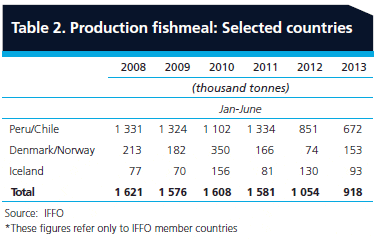
Fish oil
The fish oil price continued its steady rise, reaching new highs in mid-2013. Growing demand for aquaculture products will also increase demand and, hence, prices, as fish oil is the primary ingredient in fish feeds for carnivorous fish species. Demand for fish oil as a nutritional supplement also continues to grow. Quota restrictions on raw material species will also contribute to price pressure and volatility. Global consumption of farmed fish, which is expected to surpass the consumption of wild-caught species in 2015 (if not sooner), will ensure the demand trend remains strong. Fish oil production declined 22 per cent in the first half of 2013 compared with 2012, mainly as a result of lower production in Latin America that saw Peruvian exports decline substantially compared with 2013. Chilean exports rose, while US exports of fish oil remained stable.
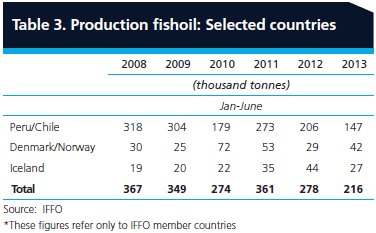
Bivalves
Demand increased for scallops, oysters and mussels in the first half of 2013 and is expected to continue, along with higher prices, for the rest of the year. Mussel trade within the EU during the first six months of 2013 was dominated by intra-EU trade, with the majority of imports coming from EU countries, mainly Spain, Netherlands, Denmark, Italy and UK. With Chile’s current mussel supply down slightly from last year, Chilean mussel farmers estimate that the high price of seeds will result in an unused capacity of 35 per cent of farming area, which could restrict supply further. However, higher export prices could compensate for the lower volume. Oyster prices have doubled over the past three years as a result of high disease-related mortality, which will keep prices high throughout 2013. In spite of the price increases, demand for oysters is good, which is generating support for oyster farming projects by governments in several South and Central American countries, including Ecuador, Venezuela and Chile. Scallops, however, are not performing as well, with European imports in the first half of 2013 dropping to their lowest level in six years. The scallop harvest is expected to be reduced in Japan and the US, resulting in higher prices. China is an increasingly attractive market for bivalve producers. Its domestic production only covers 30 per cent of local seafood demand, while its mussel consumption is growing at 20 per cent per year, and high-value oysters and scallops are also in demand.
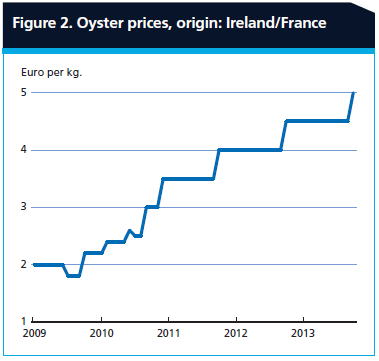
Shrimp
Lower production of farmed shrimp due to disease problems in Asia and Latin America during the first half of the year and a poor supply forecast for the rest of the year has pushed shrimp prices higher worldwide. The early mortality syndrome (EMS) problems in Thailand mean this year’s harvest production almost certainly will be half of last year’s volume. However, there have been recent signs that EMS is abating, and a supply increase is projected for the second half of 2013. Viet Nam’s production volume has also been negatively affected by disease, but India and Indonesia are expected to make up some of the production shortfall, with sources in the latter predicting total production of above 500 000 tonnes in 2013. In the US, strong interest from buyers competing for limited supply is contributing to the high prices, while the US International Trade Commission (USITC) ruled in favour of abandoning countervailing duties on imported warm-water shrimp from the seven countries that had been accused by US producers of subsidizing their shrimp industries, namely Ecuador, China, India, Viet Nam, Thailand, Indonesia and Malaysia. The Japanese market, totally dependent on imported supplies of shrimp, is also suffering slightly as a result of the rising prices, in addition to a weaker yen and increased landing costs. The current trend is weakening demand for raw shrimp and increasing preference for processed shrimp. Total Japanese imports of shrimp in the first 6 months of 2013 were 122 200 tonnes, a 1 per cent decline in volume from last year. European shrimp markets were quiet during the first six months of the year as sluggish domestic demand and high shrimp prices prompted many European buyers to withdraw from the international market. In contrast, China has been actively buying shrimp from major producing countries in Asia, particularly from India, although Canada remains its largest supplier.
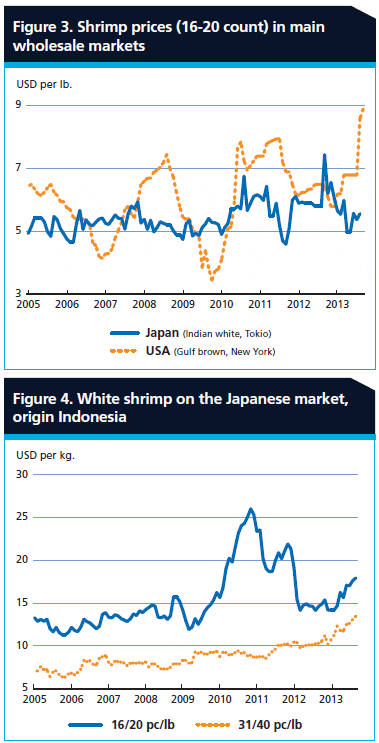
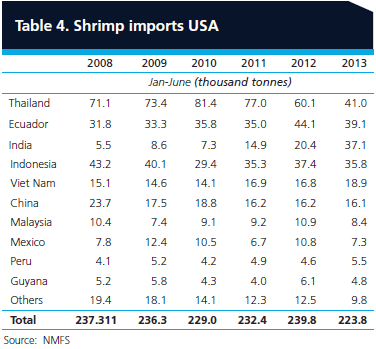
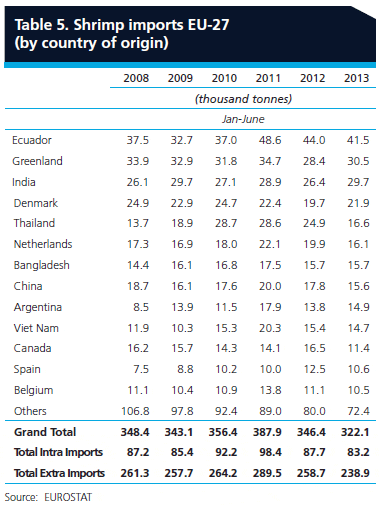
Tuna
With some variations, overall tuna landings have been lower in 2013 than 2012. The price of frozen skipjack for delivery to Thailand dropped to its lowest level since January 2012. For sashimi-quality frozen bigeye tuna, supplies are expected to be lower than last year’s, and firmer price levels are forecast. Japan, the largest sashimi tuna market, has become less active with lower imports during the first half of the year. Generally demand for sashimi tuna improves from the beginning of autumn, but this year sales were still down as a result of the warm weather. In contrast, retail demand for red meat-quality bigeye tuna remains high for Western Pacific-origin fish because the quality is good and the market is showing a preference for better quality products. Demand for fresh chilled sashimi tuna remained stable in the US, which is now the second largest market for non-canned tuna products. The canned tuna market fared better with improved imports into the EU and the US. Canned tuna imports into the US were up 14 per cent to 80 700 tonnes in the first half of 2013, while combined Italian, French, German and UK imports rose 7 per cent to 193 400 tonnes. Canned tuna demand has also increased in many nonconventional markets. Packers in Asia reported better sales in the second quarter of 2013 as customers used up low-priced inventories and the positive trend is expected to continue in the third quarter. Asian canned tuna producing countries are hopeful that they will get better access to the EU markets next year. Meanwhile, the confidence of US consumers has improved slightly as a result of positive economic indications, and there are signs of willingness to spend more on products that meet changing tastes and provide value for money. Canned tuna prices, however, will remain high.
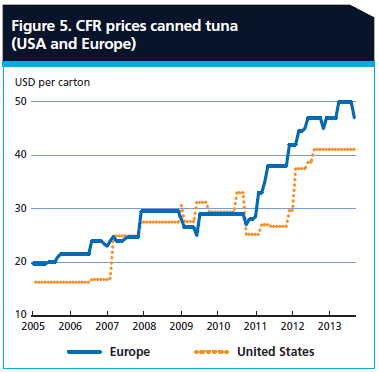
Seabass and seabream
The increasing volumes of seabass and seabream that are coming to market have led to weaker prices. In Greece, production is down somewhat, with companies suffering from tight credit and rising feed costs, but Turkey’s production continues to grow, setting Turkey on the path to become the largest producer of these species. The high volumes will keep markets well supplied and prices can be expected to weaken even further over the coming months with recovery not expected until 2014. Seabass prices are particularly under strain from production increases. Over time, markets will certainly be able to absorb the larger volumes but a more stable long-term balance will clearly need more product innovation and the development of additional markets. Taking the typical cyclical pattern of prices into account, seabass prices were significantly lower in the first half of this year while seabream prices were quite similar to 2012 levels during the same period. Despite some weakness in the market overall, the UK, US, German, Middle Eastern and Russian markets are all developing nicely, and traditional markets such as Spain and France have rebounded in 2013 from weak demand in 2012. However, volume growth for the most part was due to lower prices, especially for bass. Italy, the largest market, remains sluggish as consumers struggle with the effects of economic recession, and is not expected to turn this year.
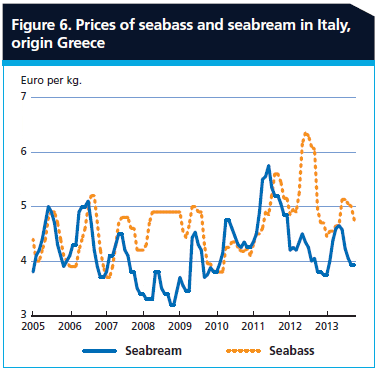
Salmon
Since the recovery from the 2011 price crash began in late 2012, the salmon market has witnessed continued growth and a positive price trajectory that has lifted export revenues to record levels, particularly for producers supplying EU markets. Part of the reason for the lucrative price levels was lower harvest volumes in the first half of the year resulting from biomass restrictions and colder water temperatures. This price trend has recently been reversed due to some evidence of weakening demand, as high raw material costs filter down the value chain. However, it appears the market balance is still sufficiently tight to halt the decline well before Norwegian export prices reach anywhere near the previous low of USD 4.5 per kg in April 2011, and seasonal demand will soon reverse the downward trend. The long-term supply outlook is for little or no growth, with reports stating that Chilean farmers will again have to adapt to maximum pen density restrictions which are being implemented in an attempt to control the spread of disease. It is hoped the resulting reduction in supply will boost prices and improve the profitability of Chilean farms that, despite good demand, continue to struggle and are likely to face future increases in feed prices. These suppliers will have to look to newer markets such as Brazil, China and also the Norwaydominated EU to compensate for Japan’s declining interest in seafood. Norwegian producers are faring much better, registering a record total export value of USD 3 billion in the first half of 2013, 28 per cent more than the same period in 2012. Despite a decline in the total volume of exports, the export volume to Norway’s top market, the EU, remained largely unchanged while the value increased. Norwegian trout exports are also performing well.
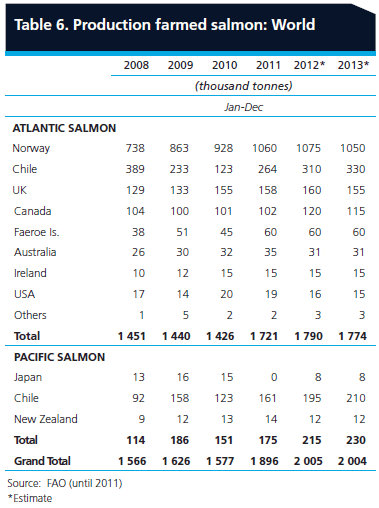
Cephalopods
Octopus supplies are more abundant, particularly from Morocco. This is reflected in busier trading in the main markets, such as Japan and the EU. Surprisingly, this has not had an impact on prices in spite of the difficult economic situation, although this can be expected to change as more product enters the market. In Mexico, the octopus fishery in Yucatan started in August and is expected to land some 12 000 tonnes during this season. Squid supplies also improved somewhat in the first half of the year. Prices are relatively high and expected to remain so. The interest in jumbo flying squid (Dosidicus gigas) in South America is increasing. Jumbo flying squid from Peru has been exported to over 50 countries. The Japanese squid market grew slightly, there was a marked increase in Italian squid imports during the first six months of this year, although Spanish imports declined. The US, which has become a major importer (and exporter) of squid over the past decade, imported somewhat less during the first half of this year. Cuttlefish supplies have been a little tighter, as reflected in international trade statistics showing declines of 21 per cent, 12 per cent and 7 per cent in imports into Japan, Italy and Spain, respectively. Cuttlefish prices should remain stable because of tight supply.
December 2013



